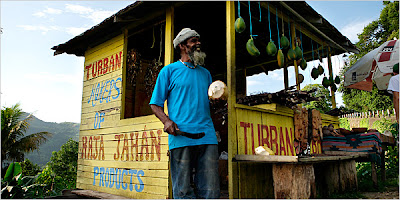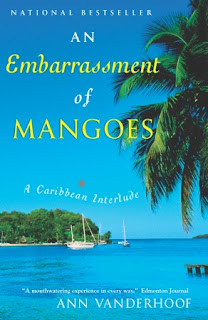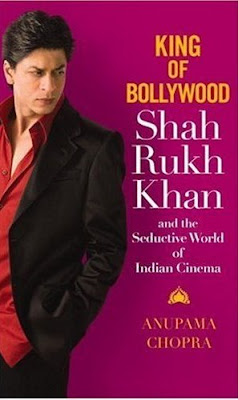 Edmund Hendrix sells sugar cane, mangoes and spider apples at Raja Jahan’s along the North Coast Road in Trinidad.
Edmund Hendrix sells sugar cane, mangoes and spider apples at Raja Jahan’s along the North Coast Road in Trinidad.pic courtesy: Chris Ramirez of the New York Times
A friend pointed me to the Travel Section of the New York Times on Sunday because they had an excellent feature on the Caribbean in general and on the eats of Trinidad in particular. As travel writer Sam Sifton took us through the country that was VS Naipaul's muse for so long and as she ate her way through "bake and shark" ( a fish sandwich) barbequed chicken, crab fritters etc., I was reminded of a book I read 2 years ago titled "An Embarrassment of Mangoes"
 Category: Travel
Category: TravelFormat: Trade Paperback, 320 pages
Publisher: Anchor Canada
Pub Date: January 12, 2005
Price: $21.00
"Embarrassment of Mangoes" is the account of a Toronto couple in their mid-40's who quit their high-paying jobs, rented their home and moved into a 42-foot sailboat to sail the Caribbean for two years. This book is part memoir, part travelogue, part nautical adventure and part recipe book. The couple sail through ports like Georgetown in Bahamas, Grenada, the Dominican Republic, Trinidad all the while treating us to vivid, warm and enchanting descriptions of the islands they visit and the fascinating islanders they meet. Altogether the Vanderhoofs visited 47 islands in 16 countries, for a total of 7,000 nautical miles ! Ann's account is entertaining, engaging and, if you enjoy sailing, packed with information on the joys and headaches of sailing.
I was lucky enough to hear the author speak at a library in Toronto and after she spoke all the attendees were treated to some of the edible goodies she discovered in the Caribbean. That night I gorged on mango and papaya salsa, pina colada cheesecake and coconut brownies. They were out of this world and prompted me to try more recipes from her book, all of which turned out wonderfully! I just wish her publishers had thought to include an index of recipes to make it easier to access in a hurry.
Here are a couple of simple recipes from Ann's awesome repertoire of Caribbean recipes:
One-Pot Coconut Brownies
3 ounces unsweetened chocolate (3 squares)
1/2 cup butter
1 1/4 cups sugar
3 eggs
1 tsp vanilla
2/3 cup flour
1/3 cup coconut milk powder
1/2 tsp baking powder
1/2 tsp salt
1/2 cup chopped walnuts or pecans
1/2 cup fresh shaved or coarsely grated coconut
# Preheat oven to 350F. Grease a 9-by-9 inch pan.
# In a medium saucepan melt chocolate and butter. Remove from the heat, and add sugar,eggs, and vanilla. Stir until smooth.
# Stir in flour, coconut powder, baking powder, salt and nuts. Mix well.
# Spread mixture in prepared pan. Sprinkle coconut shavings on the top.
# Bake for 25-30 minutes or until brownies dimple slightly when you press them in the center. (If coconut shavings begin to get too brown, cover top loosely with aluminum foil)
#Cool and cut into squares.
(Makes 16-20 brownies)
For her MANGO CRISP recipe, please go here
***********
Culled from CBC
Five authors from Asia have been shortlisted for the inaugural Man Asian Literary Prize, worth $10,000 US.
The five shortlisted works were chosen from a long list of 23 and are:
- Jose Dalisay Jr., Soledad's Sister.
- Reeti Gadekar, Families at Home.
- Nu Nu Yi Inwa, Smile As They Bow.
- Jiang Rong, Wolf Totem.
- Xu Xi, Habit of a Foreign Sky.
The Man Asian Literary Prize focuses on new works which are still unpublished in English. It was created by the same company that sponsors the prestigious Man Booker Prize, open to published authors from the United Kingdom and the Commonwealth of former British colonies.
Dalisay teaches at the University of the Philippines in Manila while Gadekar is originally from New Delhi, India. Rong was born in China and Xu Xi is a Hong Kong native of Chinese-Indonesian heritage.
Most notable on the list is Burmese author Nu Nu Yi Inwa whose book languished in the hands of government censors for a year before it was allowed to be published.
Smile As They Bow concerns the poor and socially outcast of rural Burma, also known as Myanmar. It follows the lives of three young people: Daisy James, a gay, transvestite medium, his partner Min Min and a young beggar girl. The book will be published in English in September 2008.
The long list included 11 writers from India, now whittled down to one, Gadekar. Her novel, Families at Home, is about the suicide of a young woman from one of New Delhi's leading families.
Canada's former governor general, Adrienne Clarkson, is on the international jury set to choose the winner, to be announced on Nov. 10.





































